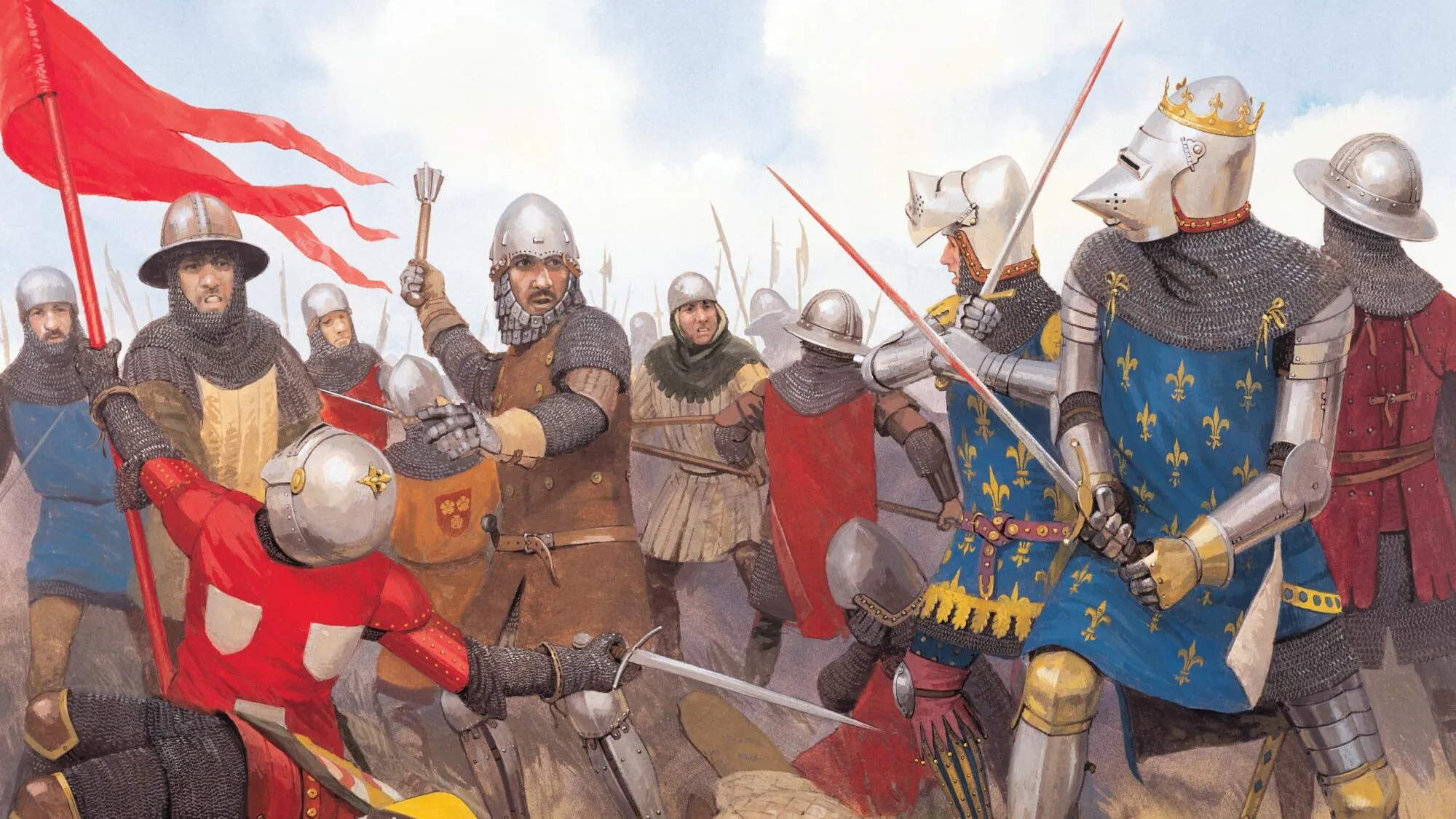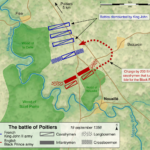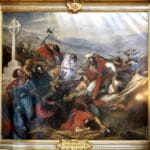Yo, let’s rewind to September 19, 1356, when the French and English went head-to-head in the Battle of Poitiers. It was like the ultimate showdown between these two European powerhouses, and get this, it completely changed the course of medieval history. So, let’s dive right into the juicy details of this epic clash and see what went down.
Battle of Poitiers: A Pivotal Clash in the Hundred Years’ War
Imagine yourself transported back to 1356, a time when the Hundred Years’ War raged between France and England. One fateful day, two mighty armies met on the battlefield near Poitiers, a city in western France.
A Clash of Titans
On September 19th, the French army, vastly outnumbering their English foes, charged into battle. But to their dismay, the English stood firm, deployed in an impenetrable formation. Their formidable archers unleashed a relentless barrage of arrows, raining down death on the French cavalry.
The English then dismounted, their longbows and axes in hand. They held their ground, fending off the French with astonishing determination. The French cavalry, once a fearsome force, struggled to break through the English lines, suffering devastating losses.
A Catastrophic Defeat
The Battle of Poitiers ended in a resounding defeat for the French. Their king, John II, was captured and held for a hefty ransom. The French nobility suffered a devastating blow, with many losing their lives on that fateful day.
English Triumph
The English victory boosted their morale and soul. It dealt a crushing blow to the French monarchy, leaving it weakened and vulnerable. This victory played a pivotal role in shaping the early stages of the Hundred Years’ War.
A Comparison with the Battle of Tours
While the Battle of Poitiers and the Battle of Tours both occurred near Poitiers, they were vastly different events. The Battle of Tours, fought centuries earlier, marked a decisive moment in European history, halting the advance of Muslim invaders. In contrast, the Battle of Poitiers was a significant defeat for the French in the Hundred Years’ War.
A Legacy Still Felt Today
The Battle of Poitiers remains an iconic event in military history. It showcased the remarkable effectiveness of English archers and tactics. The consequences of this battle reverberated through the Hundred Years’ War and beyond, shaping the political landscape of Europe for generations to come.
In 732, the Battle of the Tours forever changed the face of Europe. Led by Charles Martels, the Frankish army halted the Umayyad Caliphate’s advance into Gaul, undoubtedly shaping the course of Western civilization. What was the Battle of Tours and its lasting impact? Delve into the details to uncover the significance of this pivotal moment in history known as Tours 732.
How did the strategies and tactics employed by the English and French armies differ?
Get ready for a journey back in time, dear reader! We’re going to uncover the strategies and tactics used by the English and French armies during the Hundred Years’ War. It’s like a chess game, but with swords and armor!
In the early days, the English were like a band of hungry wolves, raiding French towns and villages. They burned houses, stole food, and killed anyone who got in their way. Their goal was to weaken France’s economy and make its people too scared to fight back.
But the French were no pushovers. They were like sneaky foxes, outwitting the English at every turn. Instead of正面冲锋 confronting them head-on, they used a tactic called the “chevauchée.” They’d ride around the English, harassing and attacking them from a distance. Think of it as a game of cat and mouse, with the French being the agile cats and the English the clumsy mice.
As the war went on, both sides switched up their strategies. The English started building castles and forts to hold onto the land they’d conquered. They also started training soldiers called men-at-arms who fought on foot. These guys were like medieval tanks, with heavy armor and sharp axes.
The French, not wanting to be outdone, adopted some of the English tactics. They started fighting on foot, too, and they even started using longbows, those powerful medieval bows that could pierce armor from a distance.
To sum it up, the English were all about smashing and looting, while the French preferred to be more strategic and avoid direct confrontations. But as the war dragged on, both sides adapted their tactics, learning from each other and becoming more deadly in the process.
The Battle of Poitiers: A Decisive Clash in the Hundred Years’ War and how did these differences impact the battle?
The Battle of Poitiers, a clash during the Hundred Years’ War, stood out from other medieval battles due to several key differences that profoundly influenced its outcome.
Clash of Numbers and Tactics
Unlike other battles where vast French armies overwhelmed their opponents, Poitiers presented a different picture. The French army outnumbered the English by a significant margin, but the English had a tactical advantage. They occupied a strategic defensive position that masked their numerical disadvantage, forcing the French to attack on English terms.
Knights on Foot, Archers on the Rise
In a departure from traditional medieval warfare where knights dominated, Poitiers witnessed the emergence of infantry as a formidable force. English longbowmen, renowned for their rapid and accurate fire, proved devastating against the French cavalry. Their deadly arrows rained down, neutralizing the mounted knights and revolutionizing battle tactics forever.
Leadership at the Helm
Commanders played a pivotal role in shaping the battle’s outcome. On the English side, Edward, the Black Prince, exhibited exceptional leadership, inspiring his troops and effectively countering the French strategy. Meanwhile, King John II of France, despite his courage, struggled to coordinate his larger army, a factor that contributed to the English victory.
The Stakes: Political and Personal
The Battle of Poitiers was not just a military conflict but a political one as well. The capture of King John II by the English had significant repercussions. It boosted English morale, weakened the French monarchy, and paved the way for England’s diplomatic triumph in the Treaty of Brétigny.
Technological Leap: The Longbow’s Dominance
The longbow, with its superior range and accuracy, proved to be a decisive technological advantage for the English. Their archers used these weapons with deadly precision, thinning the ranks of the French forces and altering the course of the battle.
Lessons Learned from Poitiers
The Battle of Poitiers showcased the importance of:
- Strategic positioning and defensive advantages
- The rise of infantry and the effectiveness of ranged weapons
- The impact of strong leadership
- The political implications of military victory
- The transformative role of technological advancements
Poitiers remains a pivotal battle that shaped the course of the Hundred Years’ War and left a lasting mark on the development of medieval warfare.
What were the immediate and long-term consequences of the Battle of Poitiers?
In 1356, the Battle of Poitiers had a massive impact on both England and France, shaping their destinies for years to come. Here’s a comprehensive look:
Immediate Aftermath:
- King John II Captured: The battle’s most significant immediate consequence was the capture of King John II of France. With their ruler imprisoned, France plunged into chaos, weakened and vulnerable.
- Unstable French Kingdom: The king’s absence left a vacuum in French leadership, weakening the monarchy and creating fertile ground for widespread unrest. Revolts and instability gripped the nation.
- English Pride and Power: England’s triumph at Poitiers bolstered their morale and enhanced their international standing. This victory gave them a strong advantage in the ongoing Hundred Years’ War.
Long-Term Impact:
- Hundred Years’ War Escalated: Far from ending this bitter conflict, Poitiers ignited the flames of resentment and mistrust between England and France. The war raged on, plagued by bloodshed and hatred.
- Growing English Identity: The victory instilled a sense of pride and superiority in the English people. It solidified their national identity and fueled their belief in their own military prowess.
- Evolution of Warfare: Poitiers showcased the devastating effectiveness of English longbowmen and dismounted infantry. It forced both sides to adapt and refine their military tactics, marking a shift in how wars were fought.
Key Takeaways:
- The Battle of Poitiers shattered French stability, weakening their monarchy and empowering their enemies.
- The battle energized England, prolonging the Hundred Years’ War and fueling English nationalist sentiment.
- The conflict underscored the changing nature of warfare, highlighting the importance of new tactics and technologies.
FAQ
Q1: What was the significance of the Battle of Poitiers in the Hundred Years’ War?
A1: The Battle of Poitiers (1356) was a major turning point in the Hundred Years’ War, resulting in a significant English victory and the capture of King John II of France. This weakened the French monarchy and led to internal divisions within the kingdom, contributing to the prolongation of the war.
Q2: How did the English achieve victory at the Battle of Poitiers?
A2: The English forces, led by Edward, the Black Prince, employed effective tactics, including the use of dismounted men-at-arms and longbowmen. They also held a strong defensive position and exploited the numerical superiority of the French cavalry by luring them into a trap.
Q3: What were the political consequences of the Battle of Poitiers?
A3: The capture of King John II had significant political consequences for France. It created a power vacuum and led to internal divisions within the kingdom, as different factions competed for control. This instability weakened the French monarchy and made it more difficult to resist English advances.
Q4: How did the Battle of Poitiers impact military tactics and strategies?
A4: The Battle of Poitiers demonstrated the effectiveness of the English tactical system, which featured dismounted men-at-arms and longbowmen. It also highlighted the limitations of traditional cavalry charges against well-positioned infantry formations. These lessons would influence military tactics and strategies for decades to come.
Q5: What were the long-term implications of the Battle of Poitiers?
A5: The Battle of Poitiers marked a turning point in the Hundred Years’ War, shifting the balance of power in favor of England. It contributed to the eventual English conquest of large territories in France and had a lasting impact on the political and military landscape of Europe.
- Unveiling Bernhard Caesar Einstein’s Scientific Achievements: A Legacy in Engineering - July 15, 2025
- Uncover who is Jerry McSorley: CEO, Family Man, Business Success Story - July 15, 2025
- Discover Bernhard Caesar Einstein’s Scientific Contributions: Unveiling a Legacy Beyond Einstein - July 15, 2025















